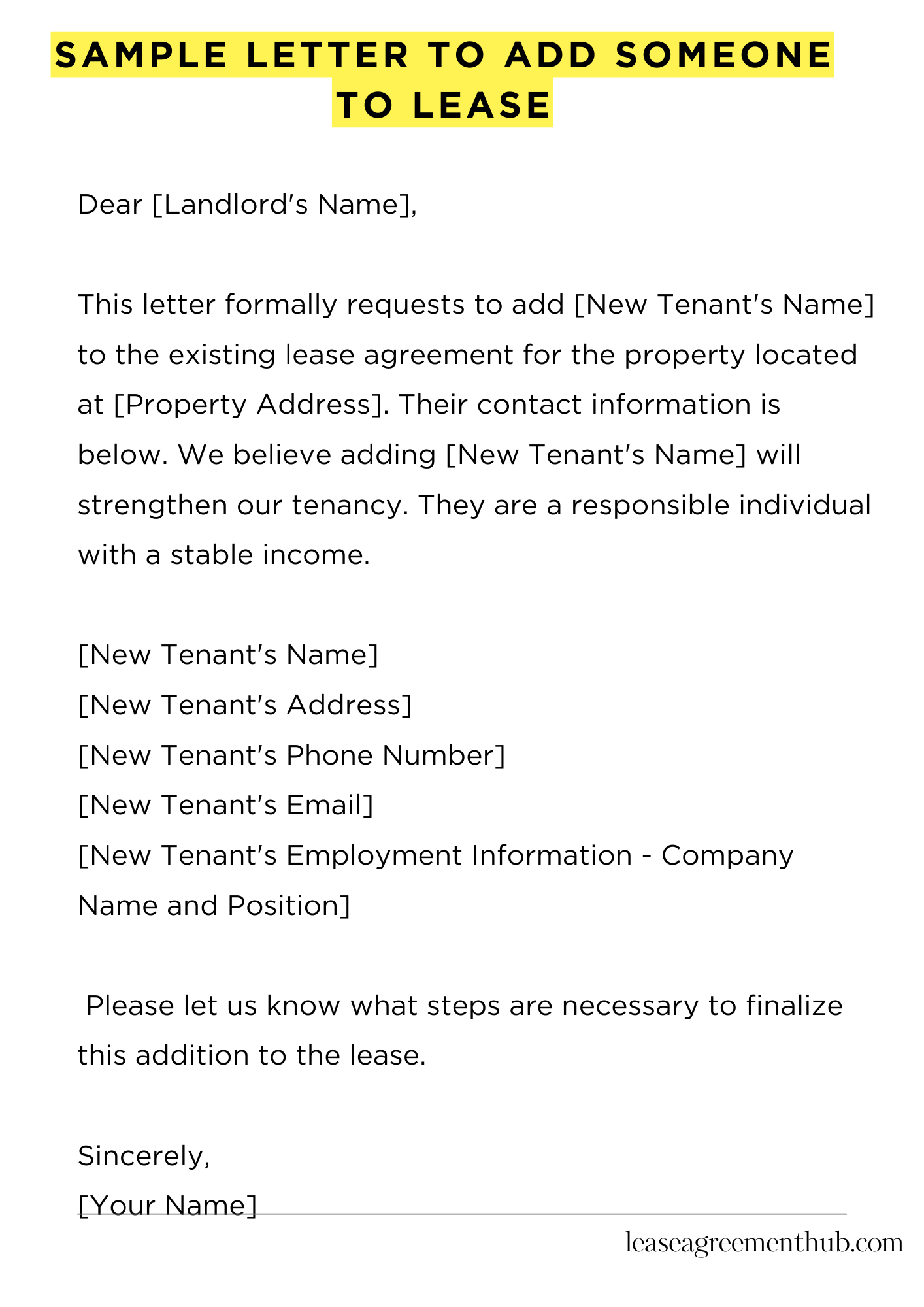Adding someone to your lease? You need a formal letter. This letter officially requests your landlord’s approval. It protects you and the new tenant.
This article provides several sample letters. These are templates. They’re designed to help you write your own. You can easily adapt them to your situation.
We’ll give you different examples. Use them as a starting point. You’ll create a professional letter quickly and easily.
Sample Letter to Add Someone to Lease
[Your Name]
[Your Address]
[Your Phone Number]
[Your Email]
[Date]
[Landlord’s Name]
[Landlord’s Address]
Dear [Landlord’s Name],
This letter formally requests to add [New Tenant’s Name] to the existing lease agreement for the property located at [Property Address]. Their contact information is below. We believe adding [New Tenant’s Name] will strengthen our tenancy. They are a responsible individual with a stable income.
[New Tenant’s Name]
[New Tenant’s Address]
[New Tenant’s Phone Number]
[New Tenant’s Email]
[New Tenant’s Employment Information – Company Name and Position]
We are prepared to provide any further information you may require. We understand the need for a thorough review of their background. We’re confident that [New Tenant’s Name] will be a positive addition to the building community. We look forward to your prompt response. Please let us know what steps are necessary to finalize this addition to the lease.
Sincerely,
[Your Name]

How to Write a Sample Letter to Add Someone to a Lease
Understanding the Ramifications
Adding an individual to a pre-existing lease agreement isn’t a trivial matter. It necessitates careful consideration of the legal and financial implications for all parties involved. This newly added lessee assumes equal responsibility for adhering to the terms of the lease, including timely rent payments and property upkeep. Conversely, existing lessees share the burden of ensuring the new addition upholds their responsibilities. This shared accountability can have significant repercussions should disagreements or defaults occur.
Initial Communication with the Landlord
Before drafting any formal documentation, initiate a dialogue with your landlord. A candid conversation is paramount. Gauge their receptiveness to adding a new lessee. Some landlords may have stringent policies regarding lease modifications. Understanding their perspective preemptively can save time and prevent potential conflicts. This initial interaction sets the tone for a collaborative approach.
Drafting the Letter: The Essential Components
The crux of the process lies in crafting a well-structured letter. It should articulate your request with clarity and professionalism. Commence with a courteous salutation, explicitly stating your intent to add a lessee. Include the prospective lessee’s full legal name, current address, and contact information. Subsequently, provide a concise rationale for the addition.
Highlighting the Prospective Lessee’s Credentials
Bolstering your request, incorporate information attesting to the prospective lessee’s financial stability and responsible nature. This could include their employment history, credit score, and references. This due diligence demonstrates your commitment to selecting a reliable co-tenant. Presenting a strong case enhances the landlord’s confidence in their decision.
Specifying the Effective Date and Responsibilities
Delineate the proposed effective date for the addition to the lease. Clearly stipulate the new lessee’s responsibilities, mirroring those of the existing tenants. This unambiguous demarcation prevents future misunderstandings regarding financial obligations and property maintenance. Precision in these details is crucial.
Requesting a Revised Lease Agreement
Once the initial letter is sent, formally request a revised lease agreement reflecting the addition. This amended document legally binds all parties to the modified terms. Secure a copy for each lessee, ensuring everyone has access to the updated agreement. This provides a tangible record of the changes.
Following Up and Maintaining Open Communication
After submitting the letter, maintain consistent communication with your landlord. Politely inquire about the status of your request. This proactive approach demonstrates your diligence and commitment to the process. Open communication fosters a positive landlord-tenant relationship.
FAQs about sample letter to add someone to lease
Adding a new tenant to an existing lease requires careful communication and documentation. A well-written letter can streamline the process and prevent misunderstandings.
What information should be included in a letter to add someone to a lease?
A comprehensive letter should include the names and contact information of all current and prospective tenants, the property address, the lease start and end dates, the proposed move-in date of the new tenant, the new tenant’s financial responsibilities (rent share, utilities, etc.), a clear statement of all parties’ agreement to the change, and the signatures of all parties involved, including the landlord’s.
How do I ensure the landlord approves the addition of a new tenant?
Clearly state the new tenant’s qualifications including credit history, employment status, and rental history. Offer to provide supporting documentation as needed. Be polite, professional, and proactive in your communication with the landlord. Showing initiative and addressing any potential concerns upfront can significantly improve the chances of approval.
What happens if the landlord rejects the request to add a new tenant?
The landlord’s decision is usually final; however, you have the right to understand the reasoning behind the rejection. It is important to respectfully request clarification. Explore alternative options, perhaps negotiating different terms or finding a new place to live.
What legal implications should I be aware of when adding someone to a lease?
Adding someone to an existing lease creates a new legally binding agreement. Ensure all parties fully understand their rights and responsibilities under the updated terms. State laws vary, so it’s important to research local tenancy laws and consider seeking legal advice before proceeding.
Is it necessary to have a formal written agreement, or is a simple email sufficient?
While a simple email might be helpful for initial contact, a formal written letter is always recommended. A written agreement protects all parties involved and provides clear documentation of the changes to the lease. This avoids future disputes and ensures a legally sound arrangement.
Related: